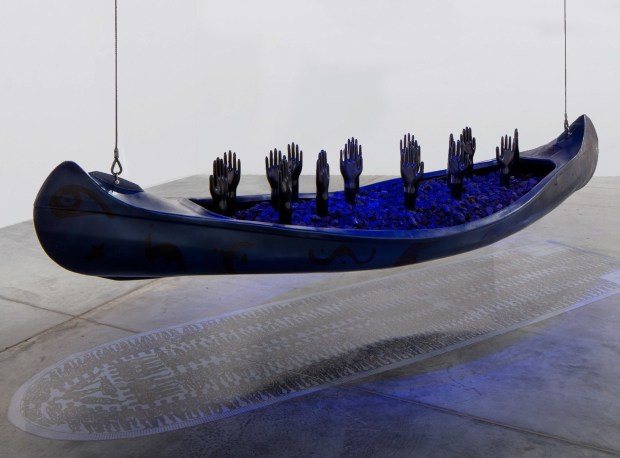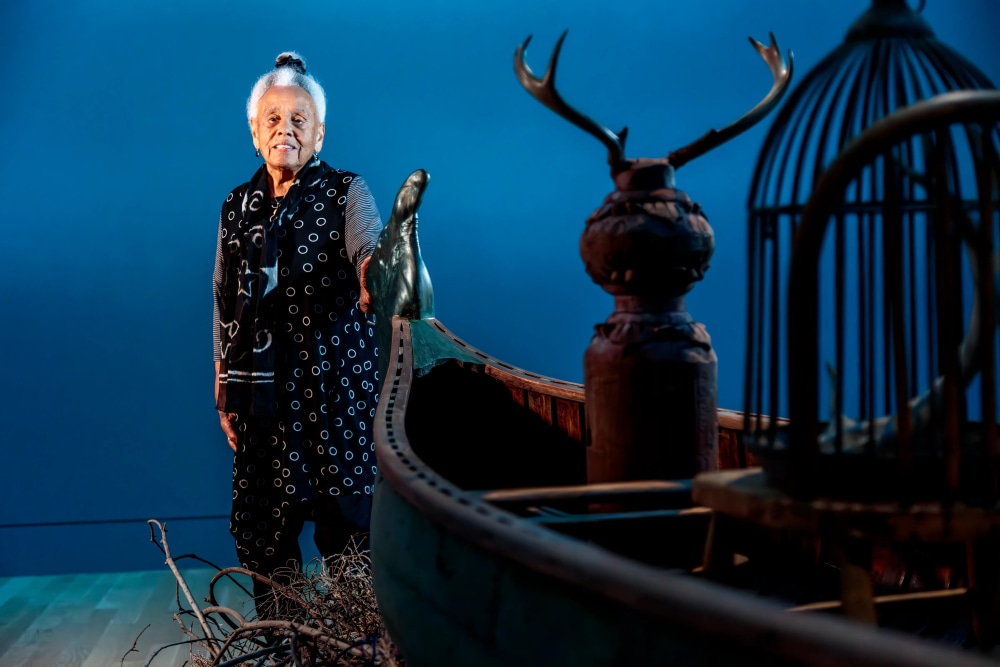

By Shelley Holcomb
There are few names that inspire as much admiration and intellectual curiosity as Betye Saar. A true vanguard in the historic Los Angeles art scene, Saar’s distinguished career as an assemblage artist has consistently pushed boundaries, intertwining history, memory, and emotion to forge a profound connection between her viewers and past generations. In an era where themes of identity are on the tip of everyone’s tongues in the art world, Betye Saar, at the age of 97, is not a newcomer to this discourse; she has, in fact, been setting the stage for us all for decades. Her steadfast dedication to addressing societal issues takes on a heightened significance in our current day (at the same potency as they have been in years past), particularly against the backdrop of ongoing conversations on social equality and racial injustices in contemporary America and abroad.
Saar’s current exhibitions — Betye Saar: New Work at Roberts Projects and Betye Saar: Drifting Toward Twilight at The Huntington Library, Art Museum, and Botanical Gardens. — stand as a testament to Saar’s enduring legacy, showcasing the breadth and depth of her work as both an assemblage artist and a cultural icon. Drifting Toward Twilight emerges as a deeply personal exploration, weaving Saar’s childhood memories of Pasadena’s landscapes with potent metaphors of migration and transition. Amid current events of immigration struggles, colonization, displacement, and the myriad of enduring challenges faced by marginalized communities, this immersive installation invites viewers to contemplate themes of journey and cultural heritage during ongoing societal turbulence.
Conversely, New Work at Roberts Projects delves into historical narratives and metaphysical truths through intimate assemblages. Incorporating elements that evoke both personal and collective memory, Saar prompts a deeper engagement with the complexities of race and identity. The juxtaposition of seemingly disparate objects within her compositions underscores the interconnectedness of past and present, urging viewers to reflect on the enduring impact of historical injustices in contemporary society.
Through her artistic practice, Betye Saar illuminates the intersections of art, history, and social activism, demonstrating a profound commitment to using art as a tool for social critique and transformation. Each assemblage becomes a conduit for dialogue, inviting viewers to confront uncomfortable truths and challenge prevailing narratives about race and power in a global context. And at a time when history is, unfortunately, repeating itself yet again, these exhibitions serve as a poignant mirror, reminding us of the urgent need for societal change and the enduring power of art to provoke reflection and inspire action.
I had the immense pleasure of interviewing Betye Saar about her two concurrent exhibitions in Los Angeles. Here is what she had to say:
Shelley Holcomb: Your current exhibitions, “Betye Saar: New Work” at Roberts Projects and “Betye Saar: Drifting Toward Twilight” at The Huntington, showcase the evolution of your artistic practice. How do these exhibitions complement each other in highlighting the breadth and depth of your work as an assemblage artist and historic Los Angeles art scene figure?
Betye Saar: Drifting Toward Twilight is very special to me since I’m from Pasadena and went to the Huntington Botanical Gardens as a child. It’s full circle. Creating this large-scale assemblage for the Huntington made me want to work on a smaller scale, and that’s what’s in my current exhibit at Roberts Projects. At first, the new works were more nostalgic, with vintage photos and female ephemera, like gloves and such. Then I brought in the tall ship bookends and African masks, and the works moved in a more ancestral and political direction. I’ve always loved the look of computer parts, microchips, and such. My grandson Spencer was discarding an old computer when I was making work for this new exhibition, and instead, he took it apart and gave it to me. Some of those computer parts are in my latest series of assemblages.
SH: Your practice spans decades, evolving through various socio-political climates. Your most iconic works challenge racial stereotypes and reclaim Black identity. How do you see your current exhibitions continuing this legacy of confronting social and racial issues, especially the issues we face today?
BS: I’m disappointed to see that the times are not changing as they should. Racism remains violently prevalent, and people today still choose to be ignorant and fearful.
I think my current exhibitions show that there is still much work to be done when it comes to fighting racism. The symbols and motifs I’ve used throughout my work are still very potent signifiers. The tall ship symbolizes slavery, and cages evoke ideas of freedom and constraint. I think I use them to remind people that this is a past, and it’s an ugly past. And in some cases, it hasn’t changed.
SH: “Drifting Toward Twilight” at The Huntington incorporates elements of nature and childhood memories, while “New Work” at Roberts Projects explores the accumulation of historical narratives and metaphysical truths. How would these differing environments influence the viewer’s experience and interpretation of your art? In what ways might they be similar?
BS: As an artist, I try to create a meaningful experience for everyone who engages with my work. This can be tricky because I don’t want to dictate the way people can respond, and there are a lot of different ways people can interpret the work. But that’s what I love about art, no two people will have an identical experience even if all other factors are the same.
SH: The concept of journey and migration is central to “Drifting Toward Twilight,” evidenced by the presence of the canoe as a symbol of movement and transition. How does this theme of a journey intersect with notions of personal and collective identity explored in your broader body of work?
BS: I have utilized canoes in some of my previous installations because they represent indigenous people who have used them in harmony with nature. But I also really enjoy the shape of the canoe. The flow of it visually and how when you are in a canoe you feel like you are gliding. Ships are a recurring symbol in my work because they can evoke so many histories simultaneously. For instance, the Huntington commission was built around a vintage canoe, and my new work at Roberts Projects has these bookends and images that reference slave ships.
SH: “New Work” at Roberts Projects features mixed-media assemblages that reveal hidden or marginalized histories. How do you approach uncovering and recontextualizing these narratives within the framework of your artistic practice?
BS: My studio is full of materials that I’ve found or collected for making my art, so just being in there inspires me to move things around. Because I’m primarily an assemblage artist, my creative process starts with the materials. I try to layer things, add and subtract until I discover a combination that feels right.
SH: As an artist whose practice has evolved over decades, how do you see these exhibitions reflecting your ongoing journey of exploration and experimentation? What insights or revelations have emerged through the process of creating and presenting these two distinct yet interconnected bodies of work simultaneously on view in the same city, Los Angeles?
BS: I’ve always believed in the power of old objects — they’ve survived, and they carry the energy of their previous owner. They have their own spirit. When I combine objects into my assemblages, sometimes their powers produce a new entity. But it’s still very personal since each viewer will see an object differently and have their own relationship to it.
Drifting Toward Twilight is an immersive installation where the viewer enters a large blue room and experiences the artwork on a life-sized scale and may even become part of it. My exhibition at Roberts Projects is more intimate, with smaller individual works in a smaller space. Each work communicates a multitude of ideas and feelings that draw the viewer in, almost like an invitation.
Betye Saar: New Work at Roberts Projects is on view through May 9, 2024 and Betye Saar: Drifting Toward Twilight at The Huntington Library, Art Museum, and Botanical Gardens is on view through November 30, 2025.
Photo by Joshua White